SYD'S PIRATES
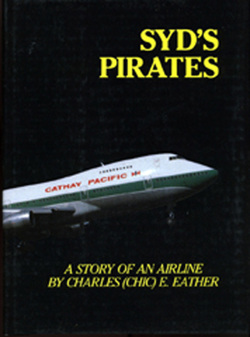
This book is now out of print, however, there are copies available over the internet. You may wish to try Amazon as they have had this book in the past.
WE FLEW IN BURMA
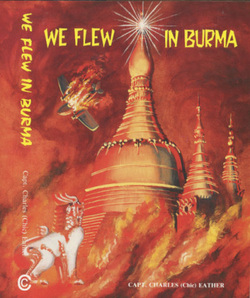
WE FLEW IN BURMA
by Capt. Charles (Chic) Eather - Author of “Syd's Pirates”
Almost from the beginning Burma has been a way-station for the pioneer flier. The remembered and the forgotten have thundered through her skies. Her rugged mountains claimed several. Still others rest in the depths of her restless seas.
The Japanese invasion during World War II brought into being the perilous Burma Road and the birth of the legendary pilots of Chennault's Fying Tigers.
With war's end, Britain gave Burma independence. This brought confusion and led to Ne Win grabbing control. Almost unabated the insurgent Karens advanced. They gained control of most of the country and the people began to starve. For a price, foreign aviators brought succour to the hungry. The Rangoon aerodrome at Mingaladon became the main point of supply.
The Karen high command ordered the capture of Mingaladon. Their occupation lasted less than a day. They inflicted minor damage and erred by not burning the BAF planes. Cathay Pacific's ground engineers witnessed this through a field of waving wheat and liquor fumes. The result of grog they purloined from an abandoned restaurant - the infamous Moutrie's “Palace of Germs”.
In Burma, the people joined the Allied cause but the Japanese are not their only modem invader, the fleeing Chinese KMT forces established the opium trade and the infamous Golden Triangle thrives to this day.
Among serious incidents are dozens of humorous anecdotes: the “Three Wise Virgins”, paradoxically ladies-of-the-evening, a lottery for the most bullet holes in the planes; the confusion of Kipling's famous pagoda at Moulmein; the inside story of Cannon's historic “moonlight flit”.
Why has the world abandoned this gentle race? The charismatic Aung San Suu Kyi holds the 1991 Nobel Peace Prize. Winning landslide election in 1990, she remains defiant under home-arrest.
How long will 38,000,000 million people be bullied by a 180,000 military force? It can't be much longer!
by Capt. Charles (Chic) Eather - Author of “Syd's Pirates”
Almost from the beginning Burma has been a way-station for the pioneer flier. The remembered and the forgotten have thundered through her skies. Her rugged mountains claimed several. Still others rest in the depths of her restless seas.
The Japanese invasion during World War II brought into being the perilous Burma Road and the birth of the legendary pilots of Chennault's Fying Tigers.
With war's end, Britain gave Burma independence. This brought confusion and led to Ne Win grabbing control. Almost unabated the insurgent Karens advanced. They gained control of most of the country and the people began to starve. For a price, foreign aviators brought succour to the hungry. The Rangoon aerodrome at Mingaladon became the main point of supply.
The Karen high command ordered the capture of Mingaladon. Their occupation lasted less than a day. They inflicted minor damage and erred by not burning the BAF planes. Cathay Pacific's ground engineers witnessed this through a field of waving wheat and liquor fumes. The result of grog they purloined from an abandoned restaurant - the infamous Moutrie's “Palace of Germs”.
In Burma, the people joined the Allied cause but the Japanese are not their only modem invader, the fleeing Chinese KMT forces established the opium trade and the infamous Golden Triangle thrives to this day.
Among serious incidents are dozens of humorous anecdotes: the “Three Wise Virgins”, paradoxically ladies-of-the-evening, a lottery for the most bullet holes in the planes; the confusion of Kipling's famous pagoda at Moulmein; the inside story of Cannon's historic “moonlight flit”.
Why has the world abandoned this gentle race? The charismatic Aung San Suu Kyi holds the 1991 Nobel Peace Prize. Winning landslide election in 1990, she remains defiant under home-arrest.
How long will 38,000,000 million people be bullied by a 180,000 military force? It can't be much longer!
AIRPORT OF THE NINE DRAGONS
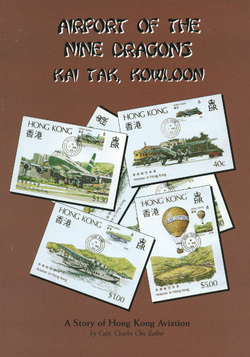
AIRPORT OF THE NINE DRAGONS
by Captain Chic Eather
Kai Tak Airport, forerunner of the great airport of Hong Kong, also known as the Airport of the Nine Dragons, in 1946 showed the ravages of the War Years with a terminal which was just a tent city, where Customs and Immigration worked on duck boards that blithely floated in every downpour.
First Officer Chic Eather's Dakota, half of the then fleet of the fledgling Cathay Pacific Airways, touched down on the macadam surface of Runway 31 in December 1946. The Captain had skipped the Dakota just above an angry China Sea heading for a sliver of light - the quarter-mile-wide Lei Yue Mun Pass. Safely through the Pass they entered an unidentifiable vacuum, which the Captain said in a hopeful voice was the Harbour!
Chic thought that was a pointless remark for the cloud seemed to have no ceiling with the torrential rain cutting the visibility to just the wipers. A slight bump heralded the landing - he still hadn't seen anything!
As the ground engineer chocked the wheels the rain eased, exposing the surrounding terrain. Rugged hills encircled the Airport, losing their peaks in the angry overcast. Here was a workplace to tax the strongest nerves.
Chic Eather is an established author. His best seller was "Syd's Pirates", which Boeing 747 Captain Martin Willing rated as "mandatory reading for anyone with even the slightest interest in the foundation of Cathay Pacific".
The aviation history of the Hong Kong Colony is a romatic story of growth with the Airport of the Nine Dragons as the focus of communication and transport. A pilot who spent nearly 30 years and 25,000 hours of jousting with the elements, the treacherous approaches and the politics of the era, Chic Father is well qualified to relate the aviation history of Hong Kong, and his avid interest in the Colony's origins and its future makes for compulsive reading.
Lester Padman - Boolarong Press Consultant.
by Captain Chic Eather
Kai Tak Airport, forerunner of the great airport of Hong Kong, also known as the Airport of the Nine Dragons, in 1946 showed the ravages of the War Years with a terminal which was just a tent city, where Customs and Immigration worked on duck boards that blithely floated in every downpour.
First Officer Chic Eather's Dakota, half of the then fleet of the fledgling Cathay Pacific Airways, touched down on the macadam surface of Runway 31 in December 1946. The Captain had skipped the Dakota just above an angry China Sea heading for a sliver of light - the quarter-mile-wide Lei Yue Mun Pass. Safely through the Pass they entered an unidentifiable vacuum, which the Captain said in a hopeful voice was the Harbour!
Chic thought that was a pointless remark for the cloud seemed to have no ceiling with the torrential rain cutting the visibility to just the wipers. A slight bump heralded the landing - he still hadn't seen anything!
As the ground engineer chocked the wheels the rain eased, exposing the surrounding terrain. Rugged hills encircled the Airport, losing their peaks in the angry overcast. Here was a workplace to tax the strongest nerves.
Chic Eather is an established author. His best seller was "Syd's Pirates", which Boeing 747 Captain Martin Willing rated as "mandatory reading for anyone with even the slightest interest in the foundation of Cathay Pacific".
The aviation history of the Hong Kong Colony is a romatic story of growth with the Airport of the Nine Dragons as the focus of communication and transport. A pilot who spent nearly 30 years and 25,000 hours of jousting with the elements, the treacherous approaches and the politics of the era, Chic Father is well qualified to relate the aviation history of Hong Kong, and his avid interest in the Colony's origins and its future makes for compulsive reading.
Lester Padman - Boolarong Press Consultant.
THE AMAZING ADVENTURES OF BETSY AND NIKI
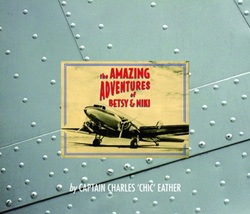
SYD'S LAST PIRATE
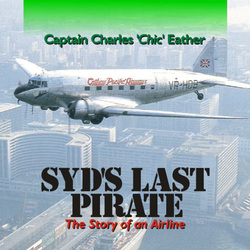
Syd's Last Pirate was not published as a book and is available on disc.

